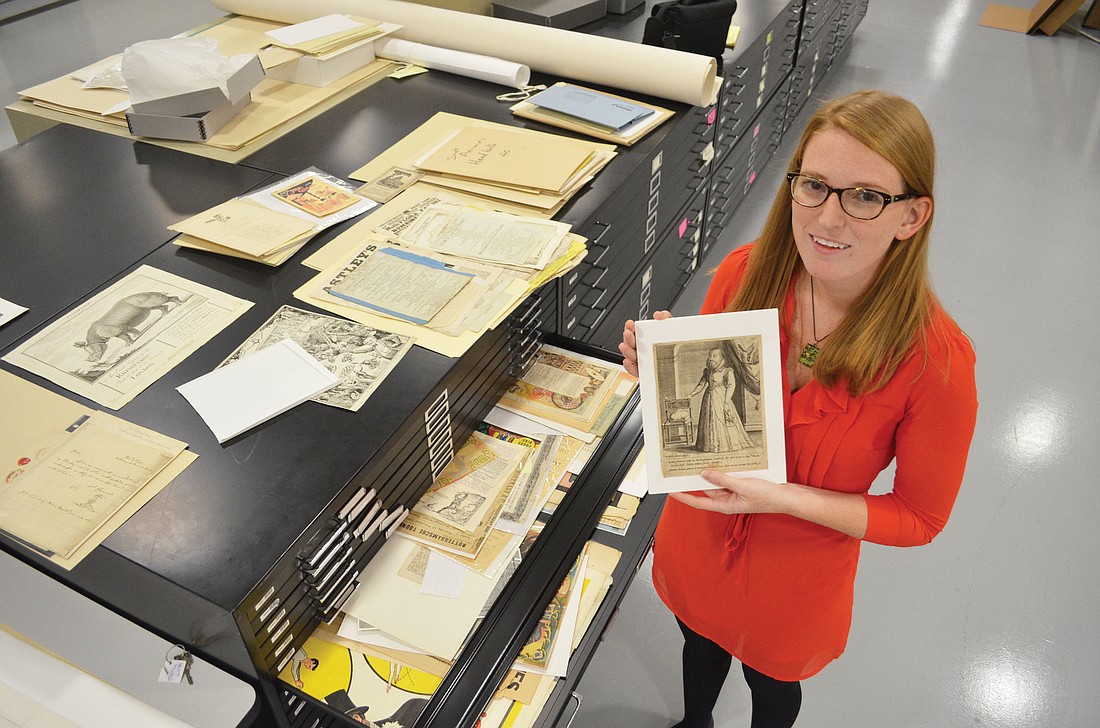- May 10, 2024
-
-
Loading

Loading

A titanic, stories-tall mural featuring the icons of circus past and present greets people as they enter the Tibbals Learning Center. Artifacts, paraphernalia and the 42,000-piece Howard C. Tibbals circus model line the halls of the center, smiling back at intrigued visitors.
But behind the big-top galore lies a hidden reservoir of scholarship and artifacts. The Howard C. Tibbals Circus Collection is stowed away behind velvet ropes and pass code-protected doors. The contrast of journeying from the colorful confines of the museum proper into the professional and scientific archives area is abrupt and shocking. But like any good wizard behind the curtain, someone has to supply the everyday work of conserving the circus history on display.
“We’re passing on the history of circus to the next generation,” says Kelly Zacovic, Tibbals collection specialist. “When I first began working here I was very awestruck. It really is incredible the variety and extent of the archive.”
The archives are home to approximately 11,000 artifacts, including the Ringling Collection, John Ringling’s papers, the Circus Collection and the Howard C. Tibbals International Collection. The latter collection contains artifacts primarily from the circus’s European origins to the mid-20th century. It includes a parade of artifacts from the foundations of the modern circus: Philip Astley’s riding school in England that was the first modern circus to incorporate animal and acrobatic performances in a ring; Joseph Grimaldi, an English actor and comedian who popularized the current tradition of the white-faced clown; prints of a panoply of exotic species of animals imported to Europe to perform in the circus; posters that are veritable works of pulp art; and political cartoons that employ circus imagery and symbolism to parody the political climate of the time.
Circus scholars and enthusiasts scour for new additions to the already extensive collection within the Ringling Archives. Once the new artifacts arrive, they are released from their secure packaging and recorded and put in a queue waiting to be catalogued. They are catalogued and then placed in separate filing cabinets or boxes based on specific criteria. New objects are then placed with similar artifacts of diverse categories such as clowns, horse tricks or oddities.
“The reason why this space is here is for researchers and academics to have access to all of these documents that chart the history of the circus,” says Deborah Walk, the Tibbals curator of the circus. “It’s a complete chart of the circus from its origin to its highs and lows.”
The archive is a fortress of three parts. The first is offices where archivists and conservation volunteers file paperwork and maintain communication with visiting scholars. Then there’s the storage facility itself, guarded by an imposing wall-sized cage with a seemingly endless array of bookshelves and file cabinets.
And the third — and most accessible to the public — segment of the archive is its digitization station.
The archives staff places various 2-D and 3-D objects on a clear white surface of a camera-and-computer apparatus. The historical relics are centered at the heart of a constellation of cameras that take photographs of the objects at every conceivable angle. Those photographs are then uploaded to the Ringling’s online compendium for the public to access at any time.
“A lot of our collection is so old and fragile that we just can’t scan them normally,” says Zacovic. “The process has become so seamless that we’re able to scan from 100 to 200 objects in a batch every few weeks.”
And the collection is as strange and elaborate as the circus itself. The oldest piece of the archives is a print of Helena Antonia, a bearded female dwarf who was a member of Archduchess Maria of Austria’s court.
“I came here not knowing anything about the circus,” says Zacovic, who studied art history in college. “But working here I’ve learned everything from hot air balloons used for trapeze and animal performances for huge spectacles to reading horse trick instructions from the 18th century.”
The Ringling Archives, including the international collection featured below, encapsulates Sarasota’s identity as a multifaceted arts oasis. It is a constant reminder of the importance of recording the history of live arts and entertainment.
“People have always had the desire to stand out,” says Walk. “And, for America, the circus grew up with America, and our entertainment is fleeting and of the moment, so we make sure to grasp and record the shadows of those original performances.”
